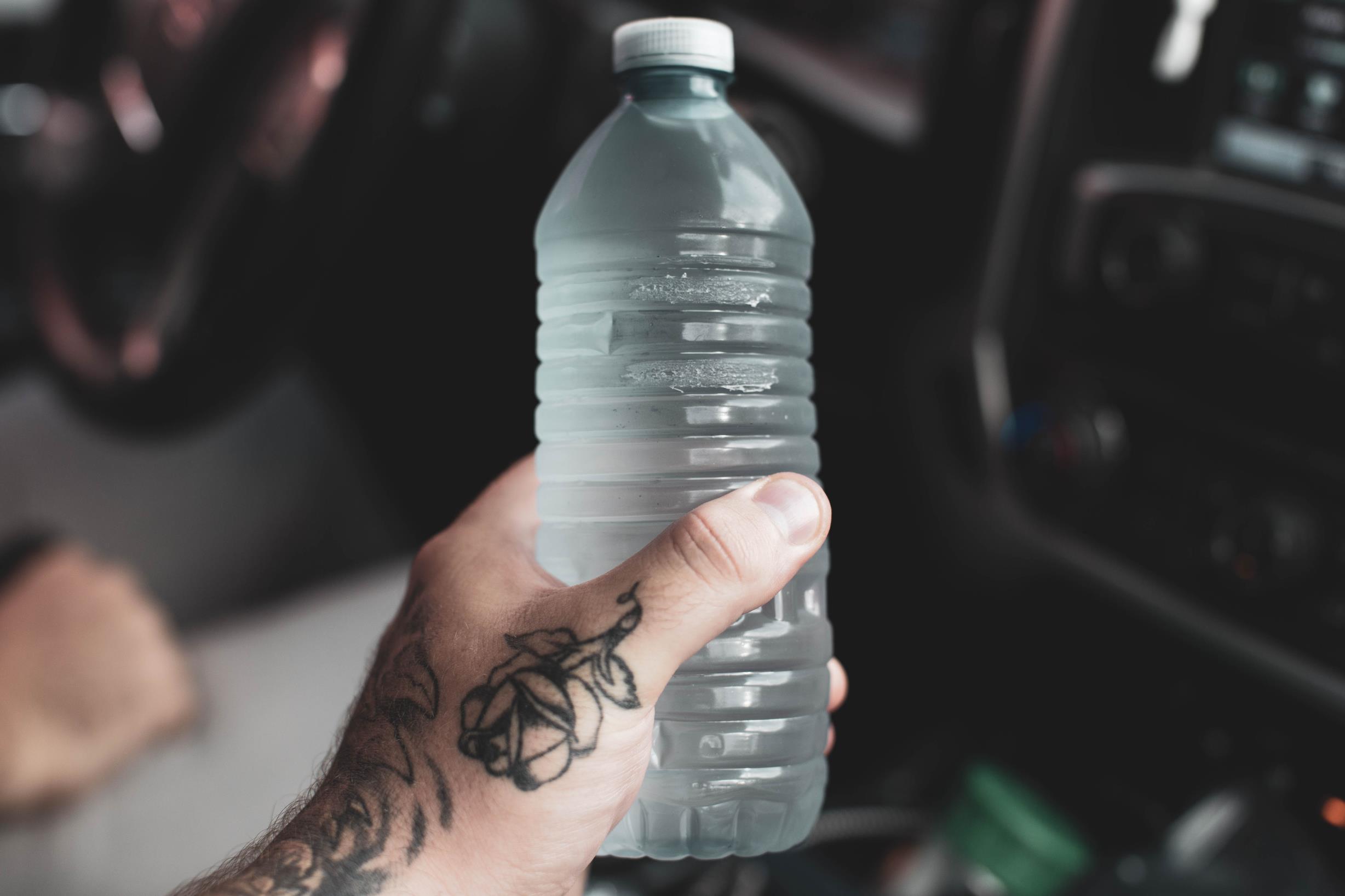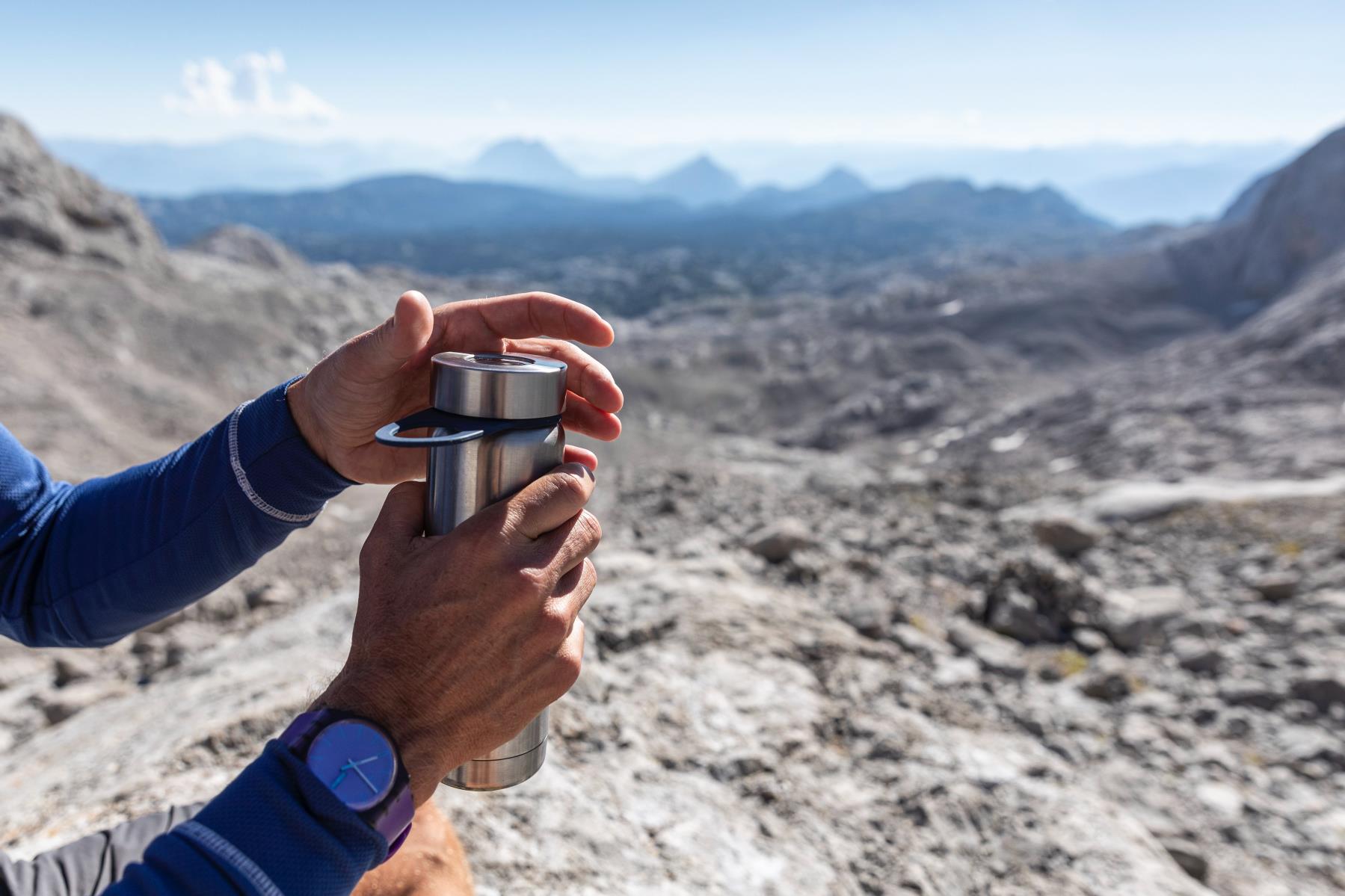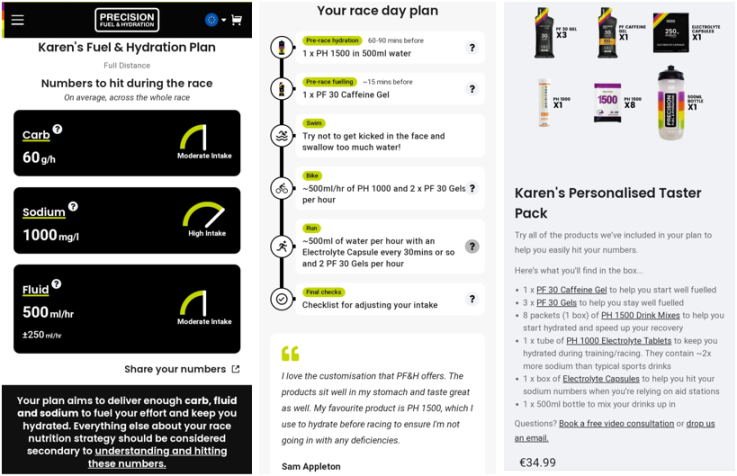How to do a Sweat Rate Test for Triathletes: Get your Hydration Right
 Karen Parnell
October 21, 2021
Karen Parnell
October 21, 2021
.png)
Determining Your Sweat Rate & What to do with the Results
Welcome to the world of triathlete sweat rate testing, where the power of your sweat holds the key to unlocking your true potential. In this blog, we explore why sweat rate testing matters, how to conduct the test, and how the results can revolutionize your training and racing strategies.
Sweat rate testing reveals your body's unique response to exertion, helping you tailor hydration strategies for optimal performance. By measuring fluid loss during exercise, this simple yet informative process provides invaluable insights that can fine-tune your hydration plan to meet your specific needs and race goals.
Join us on this transformative journey, where understanding your sweat rate becomes the catalyst for unleashing your full triathlon potential.
Sweat Rate
Sweat is natural and it's part of who we are – as men and women. Interestingly, prepubescent girls and boys sweat about the same volume. But once hormones kick in, sweating starts to vary between the sexes with men tending to begin sweating sooner and in higher volume (with activity or heat) than women.
Here’s how that looks like for a person who weighs 150 lbs/68kg, works out for 60 minutes and drinks 12 ounces/355ml of water during the workout and weighed 147.5 lbs/66.9kg at the end of the workout. Put these details into the ChiliTri sweat rate calculator. And the results are:
Sweat Rate:
24.81 ml/min or 1488 ml/hr or 0.84 oz/min or 50.3 oz/hr
How to do a Sweat Rate Test
Begin to think of your sweat losses as an hourly rate specific to the bike and to the run. Fuelling guidelines are also described at carbohydrates per hour, so this is a good base for your full race nutrition plan development. It's worth doing the sweat rate test for both running and cycling as there may be a difference.
A simple way to monitor hourly fluid losses over a workout is to measure weight changes. This strategy has been validated against sweat loss measurements in a lab, but there are some ways in which errors can creep into your calculations.
While you are preparing for a long race, it is best to check sweat losses during shorter workouts - about 60 to 90 minutes (I prefer limiting it to 60 minutes). That’s because you burn stored fuel or muscle glycogen during exercise, contributing to the weight loss. Longer workouts mean more glycogen and water loss, so it throws off the data.
It is also important to be well hydrated prior to workouts when you are completing a sweat check. Weighing sweaty clothes and hair also throws off your calculations as does consuming solid or semi-solid products during the workout, so stick with liquids.

Photo by Munbaik Cycling Clothing on Unsplash
Get your FREE 31 Structured Cycling Sessions and Training Plan
Here are some guidelines to follow:
- Make sure that you are well hydrated for these test sessions.
- Weigh in before training but after urinating
- Weigh in wearing minimal clothing- only underwear if possible.
- Complete the test session of 60 minutes and drink only water.
- After exercising, wear the same minimal clothing used for the weigh in, and weigh in again after towel drying your hair and body.
- If you go pee during training, scrap the data collection and try again next time.
- Know exactly how much fluid (water) you consume during the training session by measuring the amounts before and after training, or use a graded water bottle.
- Do a test for both cycling and running as they may be different.
Important calculations
- Every pound (453 grams) of body weight that you lose during training is equivalent to 16 ounces (473 ml) of sweat loss. Another easy conversion is one kilogram weight lost is equal to 1000 ml of sweat.
- Fluid consumed during the workout is sweat losses that you did replace, so you add it back in to the weight loss. You can also consume no fluid during these training sessions and skip that step.
Record the following: Weight before and after training; amount of weight lost; triathlon discipline; temperature; humidity; altitude; workout clothing worn; amount of fluid consumed during training; intensity of training; duration of training; date; time of day.

Photo by Jonathan Cooper on Unsplash
Get your FREE 31 Structured Cycling Sessions and Training Plan
Your standard sweat check procedure is:
- Check your weight before and after training, and calculate weight loss.
- Convert any weight loss to ounces or ml of fluid.
- Check/measure the amount of fluid consumed during training.
- Add the amount of fluid lost to the amount of fluid consumed to get total fluid losses.
- Divide the total amount of fluid lost by the number of hours of training to get fluid losses per hour.
Example
Workout: 90 minute bike workout at moderate intensity
Temperature: 65 degrees Fahrenheit / 18 degrees Centigrade, low humidity, 300 feet / 91 metres above sea level
Weight before: 160 lb / 72.57 Kg.
Weight after: 158 lb / 71.66 Kg.
Fluid consumed: 30 ounces / 887 ml
- Weight Loss: 160- 158 lb. = 2 lbs or 72.57-71.66 Kg = 0.97 Kg
- Convert to fluid loss: 2 lbs. = 32 ounces or 946 ml
- Fluid consumed: 32 ounces or 946 ml consumed
(Two 20 ounces bottles on bike, with 10 ounces remaining after ride)
- Total fluid loss: 32 ounces lost + 30 ounces consumed = 62 ounces total ( 1833 ml)
- 62 ounces fluid loss divided by 1.5 hours is 41 ounces per hour (1212 ml).
This triathlete sweats 41 ounces (1212 ml) per hour on the bike in those specific weather conditions at that given stage in their training.
To save getting your calculator out you can use the ChiliTri sweat rate calculator.
It's not always possible, or perhaps not even needed to replace all fluid lost during each hour of training and racing. But knowing your sweat rate does provide a frame of reference for hydrating to minimize your sweat losses and of course sticking with a plan that does not result in fluid overload.

Photo by Bluewater Sweden on Unsplash
Get your FREE Guide to Running Speed and Technique
Sweating and Sodium Loss
Do crusty white salt marks appear on your face and clothing when you work out? This can help determine if you are a salty sweater.
Sweat rate isn't directly related to sodium loss. You can be a heavy sweater and not necessarily lose a lot of sodium, and vice versa. But no matter how much you sweat, you lose nutrients as well as water.
Sweat contains electrolytes: sodium, potassium, chloride and small amounts of minerals (iron, calcium, and magnesium). Of all these, sodium takes the biggest hit from sweat loss, so it's the most important to replace.
Most athletes lose about 500mg sodium per pound/16oz/473ml of sweat loss, and heavy, salty sweaters can lose more than 1500mg sodium each hour.
Because these electrolytes are essential to proper hydration, it’s important to also replace them after a workout. It’s difficult to measure exactly how much sodium and other electrolytes you lose in sweat, so you should contact a sports dietitian to determine the ideal amount you should be replacing or take a look at BESTZEIT who can provide you with a home sweat rate kit. They sometimes give these out at IRONMAN® events so keep your eyes out for these.
Post-Workout Hydration Tips
Once you know your sweat rate, you can develop a rehydration plan that’s tailored to your body.
How to interpret the test and use it in your training and on race day are very personal to your race distance, race conditions, sweat rate, salt loss etc. This tool from Precision Fuel and Hydration is a great way to narrow down your exact needs. Precision Fuel and Hydration Planner. Below shows and example of your specific race advice from the planner.

Precision Fuel and Hydration Race Planner Results Example
Products like Precision Hydration tabs or OTE hydro tabs which are packed with electrolytes to help you replenish the salts you lose in sweat.
For example one eight-calorie tablet from OTE is needed per 500ml of water, along with important hydration salts, these also contain vitamins B6, B2 and B1. These tabs are available in four different flavours: orange, pink grapefruit, blackcurrant and lemon - pink grapefruit is my favourite and also contains caffeine.
The Precision Hydration PH1500 16 Kcal tabs contain 1500mg of Sodium, 250mg of Potassium, Calcium of 48mg and 24mg of Magnesium.
Whatever hydration brand you chose make sure you have checked they are batch tested using a checker like this one from Informed Sport.
What is the difference between Hydration Tabs and Electrolyte Powder?
Both hydration powders and tabs are effectively the same thing in that they are effervescent substances (dissolve in water) that contain electrolytes and sometimes other substances such as vitamins, glucose and sweeteners, dependant on the specific product in use. They both aim to keep the user hydrated during and after exercise, by replenishing salts lost through sweat. How they differ, however, is in their form.
A powder must be spooned into water and measured out depending on desired quantity, and a tab can be considered more convenient as it is already portioned out and easier to transport; all the user needs to do is simply plop one into a bottle and go. You may find powders to be slightly better value for money.
It's also worth looking to see if they contain carbs as well as electrolytes so you know what you are replenishing and you may need to add other foods to ensure you are eating the right energy on top of water and salts.
Precision Hydration do offer powders as well like the PH1500 powder which come in individual packets.
Precision Hydration 1500 Powdered Sports Drink
Get your FREE Guide to Running Speed and Technique
What is hyponatremia?
Hyponatremia is a condition that develops as a direct result of low sodium levels in the blood. Levels are reduced due to too much water in the body diluting the sodium in the blood, this is a common cause of potentially life-threatening issues such as diuretic use, liver disease and heart failure.
However, it can also occur due to excess sweating and subsequent rehydrating with liquids that don’t contain salts to replace those lost. This is why it is important to consider adding electrolyte tabs to your refuelling arsenal during particularly hard, hot, or long efforts.
Conclusion
Many races take part in the summer months which tend to be hot and can be humid so understanding how much you sweat per hour and hence what you need to replenish is very important. You can do a home test to understand your sweat rate for the run and bike so you can know how much fluid you need during your race.
There are rough guidelines for how much sodium you need but to understand this fully (everyone is different) you can do more scientific tests like those offered by Bestzeit. You can also use the planner from Precision Hydration.
Creating a a nutrition and hydration plan for race day based on your data gathered during training can make the difference between PB and DNF!
Would you like a free training plan? Claim your free plan or e-book.
Karen Parnell is a Level 3 British Triathlon Coach and Coach Educator, IRONMAN Certified Coach, 8020 Endurance Certified Coach, WOWSA Level 3 open water swimming coach and NASM Personal Trainer and Sports Technology Writer.
Karen is currently studying for an MSc in Sports Performance Coaching at the University of Stirling.
Need a training plan? I have plans on TrainingPeaks and FinalSurge:
I also coach a very small number of athletes one to one for all triathlon and multi-sport distances, open water swimming events and running races, email me for details and availability. Karen.parnell@chilitri.com
Get your FREE Swim Workouts for Triathletes E-book
Get your FREE Open Water Swimming Sessions E-Book
Get your FREE Guide to Running Speed and Technique
Get your FREE Sprint Triathlon Training Plan
Get your FREE 31 Structured Cycling Sessions and Training Plan

Photo by Jenny Hill on Unsplash
Interesting Facts from BESTZEIT
Sweat glands
Humans have between 1.5 - 5 million sweat glands. These are divided into eccrine and apocrine sweat glands. The eccrine sweat glands are responsible for cooling and have a density of up to 700 per cm2
Thermoregulation
Sweating is primarily used for thermoregulation, through sweating the sweat evaporates on the skin's surface. The resulting evaporation coolness is conducted inwards via the bloodstream and the core body temperature is regulated.
salt = sodium ?
Wrong, our normal household salt is called sodium chloride. The salt we eat every day consists of 39% sodium and 61% chloride.
1g of salt = 390mg of sodium and 610mg of chloride
To replace 1000mg of sodium, you need about 2.5g of table salt
Hyponatremia
If no electrolytes are supplied during exercise or in everyday life, the sodium concentration in the blood drops. One speaks of hyponatremia when <135mmol/l blood (normal are 135-145mmol/l). Due to the osmotic difference, the tissue swells and leads to headaches, dizziness, coma or even death.
Sodium
Most of the sodium in the body is found in the blood and in the intercellular space. Sodium's role is to regulate the absorption of fluid in the blood. It has a major impact on stimulus transmission and muscle function.
Cramps
There are at least as many theories for cramps as there are for sore muscles. Cramps can have different reasons. Braulick, Kyle W., et al. 2013 found it wasn't due to fluid or electrolyte deficiencies, but carbohydrate drinks with electrolytes could delay cramps.
Power loss
If there is a fluid deficit during sport, the blood volume, more precisely the liquid part of the blood, the blood plasma, decreases. Due to the changed composition, the blood is more viscous and the transport of oxygen becomes poorer. Since the aerobic metabolism is dominant in endurance sports, performance is restricted as a result.
Hydration status
Hydration status is difficult to measure, but it can be estimated by urine color and volume. The darker and the less, the more dehydrated you are. The lighter and the larger the amount or the more often you have to go to the toilet, the better you are hydrated.
References
Gender Differences in the Sweat Response During Spinning Exercise, Lynton Tempest Hazelhurst, Tshwane
University of Technology and Nico Claassen, University of Pretoria.
Precision Fuel & Hydration (precisionhydration.com)
Sports Supplements Certification | Informed Sport (wetestyoutrust.com)
.jpg)
How to perform an athlete sweat test Infographic from ChiliTri
If you would like a PDF of this infographic get in touch
FAQ: Sweat Rate and Testing
What is sweat rate?
Sweat rate refers to the amount of sweat produced by an individual's body over a given period of time, typically measured in millilitres per hour (ml/hr) or litres per hour (L/hr).
Why is sweat rate important?
Sweat rate is important because it provides valuable information about an individual's hydration needs during physical activity. Understanding sweat rate helps determine the appropriate fluid replacement strategy to prevent dehydration and optimize performance.
How is sweat rate measured?
Sweat rate can be measured by conducting a sweat rate test. This involves weighing the individual before and after exercise while accounting for any fluid intake or urine output during the test period. The difference in weight, combined with the exercise duration, helps calculate the sweat rate.
What equipment is needed for sweat rate testing?
To measure sweat rate accurately, you will need a reliable scale to weigh the individual before and after exercise. Additionally, you may require a stopwatch or timer to record the exercise duration and measuring containers to collect any fluids consumed during the test.
How long should the sweat rate test last?
The duration of the sweat rate test depends on the activity being performed. Generally, it is recommended to conduct the test for at least 60 minutes, but it can be longer for endurance activities or specific training situations.
I’m a triathlete, do I need to do more than one sweat test?
Yes, it’s advisable to do a sweat test for both the run and the bike.
Can sweat rate vary between individuals?
Yes, sweat rate can vary significantly between individuals. Factors such as body size, fitness level, acclimatization to heat, and genetics can influence sweat rate. Therefore, it is important to determine an individual's sweat rate through testing rather than relying on general guidelines.
What are some considerations for accurate sweat rate testing?
To ensure accurate results during sweat rate testing, it is crucial to consider the following: avoid using diuretics or excessive fluid intake prior to the test, minimize clothing weight, account for any fluid intake or urine output during the test, and conduct the test in a controlled environment (e.g., no wind or extreme temperatures).
How can sweat rate data be used?
Sweat rate data can be used to customize hydration strategies during exercise or physical activity. By knowing how much fluid an individual loses through sweat, it becomes possible to develop a personalized hydration plan that helps maintain optimal performance and prevent dehydration.
Are there any risks associated with sweat rate testing?
Sweat rate testing is generally safe; however, it's important to note that excessive dehydration during the test can be harmful. It's crucial to monitor the individual closely, ensure proper hydration before and after the test, and stop the test if any signs of distress or discomfort occur.
Can sweat rate change over time?
Yes, sweat rate can change based on various factors, including changes in fitness level, body composition, acclimatization to heat or altitude, and hydration status. Regular sweat rate testing can help track these changes and adjust hydration strategies accordingly.
#sweatrate #sweatrateresults #athlete #triathlete #triathlon #chilitri #sweatratetest #swimmingtrainingplan #cyclingtrainingplan #runningtrainingplan #swimming #cycling #running

